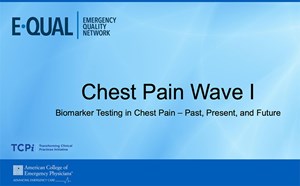Read the Full Transcript
- [Brian] Welcome to the next module in the ACEP Quality Measure module series. Today's topic is Anatomy of a Quality Measure. My name is Dr. Brian Krakover. I am an ACEP Quality, Administration, and Informatics Fellow. And today's topic, we will go over what is important to know about clinical quality measures, what clinical quality measures are, and we'll walk through some common questions concerning them. So our background is going to cover, what is a clinical quality measure, why do we use clinical quality measures, why are clinical quality measures relevant to electronic health record incentive programs? We'll talk about in the anatomy of a clinical quality measure, what CMS is, EHR incentive program, meaningful use stage and reporting requirements are. We'll go through a walkthrough of some common questions concerning CQMs, and we'll go over some resources on where to find authoritative information at the end. So getting started, what is a clinical quality measure? A clinical quality measure is a mechanism used for assessing the degree to which a provider competently and safely delivers clinical services that are appropriate for the patient in an optimal timeframe. So you can see on the right, the National Quality Forum has a standard template. This particular measure is performing blood cultures in the emergency department prior to initial antibiotics received in the hospital. It's an inpatient measure that does affect us in the ED, and we'll go over a couple of others later in the presentation. As you can already see, there's a standard format that these quality measures have and that lends them very well to being incorporated into electronic health records as well as data analytics and more advanced methods of collecting and analyzing this data, which is one of the reasons they're so useful. Why do we need quality measures? Well, they're important to CMS. The Centers for Medicare and Medicaid services are the driving force in how we get paid for quality. They set a lot of the criteria and it is up to us to find ways to meet those requirements. So measuring the quality of our patient care drives improvements and CMS programs require the use of clinical quality measures to help us ensure that quality of care is being delivered. The bottom line is we have to measure what we do according to defined standards in a clinically meaningful way in order to inform our patients, our payers, and our fellow providers and policy makers. It's also important that we take a leading role in defining what quality is in our specialty. The Centers for Medicare and Medicaid services or CMS remains the dominant player in the determination of how hospitals and providers are reimbursed for quality. Currently, CMS is transitioning from a pay-for-reporting to a pay-for-performance system. Along with this is the concept of value-based purchasing. The first step in this transition is value-based purchasing, CMS directs its influence through three main programs, one of which is the Physician Quality Reporting System or PQRS. Providers are responsible for reporting measures via claims through their billing companies. These measures include Medicare Part B patients only, but do include both admitted and discharged patients. The next is the Outpatient Protect Prospective Payment System, or OPPS. Hospitals are responsible for reporting these measures, which include all patients regardless of payer with a broad range of dispositions including admissions, transfers and discharges. And the third is the inpatient prospective payment system, or IPPS. Hospitals are responsible for reporting these measures, which include all admitted patients, regardless of payer. So the three main reporting programs are the physician quality reporting system, the outpatient prospective payment system, and the inpatient prospective payment system. The CMS hospital inpatient value-based purchasing program became law on July 1st, 2011, and applies to payments for discharges occurring after October 1st, 2012. CMS believes value-based purchasing will reduce costs by encouraging value-added healthcare. The program is an evolution of the hospital inpatient quality reporting program where IQR was considered pay-for-reporting, value-based purchasing is pay-for-performance, but given that funding is derived from a reduction in payment, it's more accurately described as a non-pay for non-performance rather than a pay-for-performance. CMS believes that value-based purchasing will be a vehicle to incentivize value and outcome versus just volume. This is a significant change as CMS becomes a purchaser of services instead of a payer of claims. What does all this mean for the specialty of emergency medicine? Well, many of these processes of care could feasibly touch on emergency care, but four inpatient quality measures are specifically relevant to emergency care. And those are AMI-7a, which is the administration of thrombolytics within 30 minutes of arrival for ST elevation MIs. AMI-8a, which is primary PCI within 90 minutes of hospital arrival for STEM use. PN-3b, which is drawing blood cultures or performing blood cultures in the ED prior to initial antibiotic received in the hospital. And PN-6, which is pneumonia patients being given the most appropriate initial antibiotic. We'll discuss briefly the different types of quality measures based on the examples from CMS that we've showed as well as hypertension and be able to apply what you've learned to the big four we represented. So there's two main types of clinical quality measures. There's process measures and there are outcome measures. Process measures focus on a process that leads to a certain outcome. This is a scientific basis usually exists for believing the process will increase the probability of achieving a desired outcome when executed properly. Some examples of this are door to balloon time for STEMIs, door to needle times for t-PA or time to first antibiotic in sepsis. These are grounded in evidence-based medicine, but are subject to change in revision as the science evolves. Outcome measures are a measure that indicates the result of a performance of a function or process. Some examples are connecting timeliness of ED intervention to reduction in mortality or reducing inpatient length of stay resulting from ED or EMS interventions. Where do they come from? Well, anybody can create a clinical quality measure. This is good and bad, but to be used in a CMS program, they require consensus endorsement and must meet the following criteria. And the four criteria are the importance to measure and report, scientific acceptability of measured properties, usability and feasibility. CQMs are reported in a variety of ways. They can be reported by manual chart review, referencing manual specifications for the measures, or as is being done increasingly, electronic reporting via Epic reports, Tableau or other data analytics. And there are newer technologies that leverage artificial intelligence as well as electronic health records to report in real time. How does this apply to electronic health records? Well, the Recovery Act specifies three components of meaningful use, the use of certified electronic health records in a meaningful manner, i.e. electronic prescribing, Care Everywhere for data exchange. The use of certified EHR technology for electronic exchange of health information to improve quality of healthcare or data exchanges, and the use of certified EHR technology to submit clinical quality measures and other such measures selected by the Secretary of Department of Health and Human Services. The High Tech Act specifies that quality measures reported through an electronic health record adhere to specifications including data elements, logic and definitions. They can be captured or stored electronically in a manner that allows transmission in a structured, standardized format. Ergo, the High Tech Act has, amongst many things, established a common language and format so that we can all talk together through electronic health records. This also streamlines and makes the process of collecting quality measure data much more efficient. What are some of the components of this electronic specifications set? Well, there are four major specifications. They have a measure overview and description. They measure logic, programming language to code the EHR, such as a and or, if this, then that. Measure code lists. And these are codes referring to data elements either from ICD-10, SNOMED, and the like, and that they also have a quality data set elements or data models for e-specifications. The four major components of a measure, regardless of the data source that determine what data is reported to CMS for the EHR incentive program are number one, the initial patient population, a denominator, a numerator, and excluded patients. In this example, we see the National Quality Foundation Measure 13, which is on blood pressure measurement. So the first line it list its name, it hasn't been given a measure ID yet, but there is a steward, which is in this case is the American Medical Association Physician Consortium for performance improvements. So these are the organization that submitted the quality measure and a description of it. In this case, it's a percentage of patients aged 18 years and older with a diagnosis of hypertension who have been seen at least two office visits with blood pressure recorded. So there we have the elements that we discussed. It has a title or a name. It has a numerator, it has a denominator, and it has any, you can imply exclusions for anybody under the age of 18. And then it lists at the bottom there's clinical recommendation statements and improvement noted notations. This is a standard format that these electronic quality measures use in order to facilitate easier access to the data. So in this particular case, our initial patient population or the group of patients the performance measure is designed to address is patients over the age of 18 with an active diagnosis of hypertension who have been seen at least two or more visits by their provider. So the measure is out of the initial patient population and which is the logic used patient characteristic or a birth date or age of greater than or equal to 18 years. And an active diagnosis of hypertension, and two counts or more of an encounter for an outpatient or an encounter in a nursing facility. The denominator in this case is the subset of the initial patient population. And for our example, it's patients greater than or equal to 18 years old with an active diagnosis of hypertension who have been seen for at least two or more visits by their provider. Yes, that's the same population as the initial patient population. So that's our denominator. The measure is going to be and all patients in the initial patient population. So out of all patients, excluding the ones under 18 who have an active diagnosis of high blood pressure and who have been seen by their provider at least two times, we're looking at which one of them have an elevated blood pressure. So the numerator is the subset of the denominator for whom a process or outcome is measured. And in this case it's have a recorded blood pressure. So the numerator is going to be out of the initial patient population in the defined characteristics who have a physical exam finding called systolic blood pressure and a physical exam finding called diastolic blood pressure. So that's how these are created or programmed or coded in an electronic format so that EHRs can communicate across different platforms using the same standards. In this case, the exclusions are gonna refer to cases in which the action specified and the measure was not performed due to allowable reasons, can be taken from the denominator or numerator depending on the measure. From this example, there really aren't any specified exclusions. We've just sort of set the pool of patients to be greater than or equal to 18. And in this case, they're listed with the and logic of none. But depending on how you determine your desired denominator, you can take the exclusions out before. So the clinical quality measure notation, if we were to do the math on this for reporting purposes, is say for example, out of an initial population of 200, the denominator is all 200. Our numerator will be a hundred with exclusions of zero. The measure's typically expressed as a ratio of 100 out of 200. So there are some common questions that people have when learning this topic, what if there are no patients in my patient population? So if accurate, it's perfectly acceptable to report zero in the denominator as long as the true value is displayed and calculated by the certified EHR. As long as you're verified that the data is accurate, there's absolutely nothing wrong with reporting a population of zero. What about some other federal programs? This one specifically refers to currently Medicare patients, as CMS is the main driver or the main payer of this. Other federal programs may require separate reporting. And at this time, the common language is still being agreed upon, but seeing as how CMS is the largest payer in this pool, the way things are going will probably continue. Healthcare organizations and providers must report for each initiative for which they qualify and choose to participate. You can't submit one aggregate measure for all entities in a healthcare organization and have it count for all. So what are some key resources to learn more? You can get information, tip sheets and more at CMS's official website for the EHR incentive programs at www.cms.gov/EHRIncentivePrograms. cms.gov also has a site that's listed here with electronic specifications information and healthit.hhs.gov has a number of good lessons there as well as products about learning about certified EHRs. So that concludes our initial module on the anatomy of a quality measure. Thank you for your attention and look forward to the next module.




